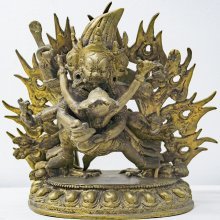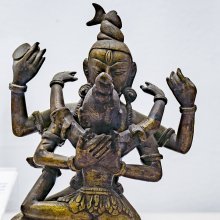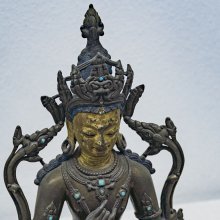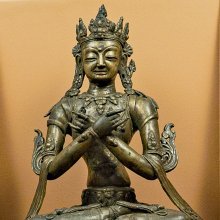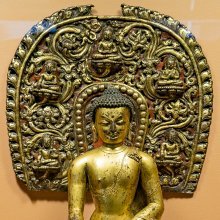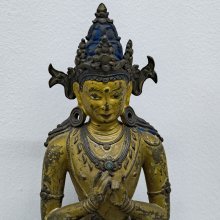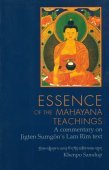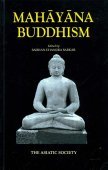Vajrayana, Vajrayāna, Vajra-yana: 8 definitions
Introduction:
Vajrayana means something in Buddhism, Pali, Hinduism, Sanskrit, the history of ancient India, Hindi. If you want to know the exact meaning, history, etymology or English translation of this term then check out the descriptions on this page. Add your comment or reference to a book if you want to contribute to this summary article.
Alternative spellings of this word include Vajrayan.
Images (photo gallery)
(+35 more images available)
In Buddhism
Tibetan Buddhism (Vajrayana or tantric Buddhism)
Source: WikiPedia: VajrayanaVajrayana is a complex and multifaceted system of Buddhist thought. Vajrayana refers to one of three vehicles or routes to enlightenment, the other two being the Theravada and Mahayana. Founded by the Indian Mahasiddhas, Vajrayana subscribes to Buddhist tantric literature. Vajrayana is also known as Tantric Buddhism, Tantrayāna, Mantrayāna, Secret Mantra, Esoteric Buddhism and the Diamond Way or Thunderbolt Way.

Tibetan Buddhism includes schools such as Nyingma, Kadampa, Kagyu and Gelug. Their primary canon of literature is divided in two broad categories: The Kangyur, which consists of Buddha’s words, and the Tengyur, which includes commentaries from various sources. Esotericism and tantra techniques (vajrayāna) are collected indepently.
General definition (in Buddhism)
Source: Wisdom Library: BuddhismVajrayana:—The highest vehicle in Tibetan teachings.
Source: Google Books: Buddhist Tantra: A Philosophical Reflection and Religious InvestigationAccording to Vajrayāna Prajñā and Upāya reside within the body of sentient being. Upāya resides in the high plexus (Uṣaṇīṣa Kamala) and the Prajñā dwells in the lowest plexus (Mūlādhāra), the sacrococcygeal plexuses. The central objective of the Tantra, Sādhanā is to awaken the Prajñā (Herukā), fro mthe lowest plexuses and making her proceed in an upward movement till she becomes united with Upāya in Uṣaṇīṣa Kamala. In Vajrayāna mand represents Upāya and womand represents Prajñā. The esoteric commingling of the two is the giver of supreme bliss (Mahāsukha), it leads from spiritual discipliune and yogic control, it leaves to the spiritual oneness, which is the state of the Boddhicitta. Vajrayāna accepts and leads to the equipollence of Prajñā and Upāya.
Source: archive.org: The Indian Buddhist Iconography (b)Vajrayāna (वज्रयान) refers to the path (yāna) of Tantric Buddhism.—The Tantras were a development of the Yogācāra which was inspired by the Śūnyavāda of the Madhyamakas. Vajrayāna marks a step in advance even of the Yogācāra thought. [...] Vajrayāna is characterized as the “Path which leads to perfect enlightenment” or what they call in Sanskrit “anuttara samyak sambodhi”. Vajrayāna literally means the adamantine path or vehicle, but its technical meaning is the “Śūnya Vehicle” where Śūnya is used ina special sense to represent Vajra.
The Vajrayānists refer to Śūnya in all their writings, but this is not the Śūnya of the Madhyamakas about which neither existence nor non-existence nor a combination of the two nor a negation of the two can be predicated. [...] The Vajrayāna which is a direct outcome of the Yogācāra school introduced a new element or the element of Mahāsukha “eternal bliss” to their conception of liberation. The evolution of Buddhism became complete and found full expressionin Vajrayāna.
Source: Buddhist Door: GlossaryVajrayāna is also called Tantrayāna.
Source: Shambala Publications: GeneralVajrayāna Skt., lit., “Diamond Vehicle”; a school of Buddhism that arose, primarily in northeast and northwest India, around the middle of the first millennium. It developed out of the teachings of the Mahāyāna and reached Tibet, China, and Japan from Central Asia and India along with the Mahāyāna. This movement arose from a need to extend the worldview of Buddhism to inveterate “magical” practices and is characterized by a psychological method based on highly developed ritual practices. The Vajrayāna had its origin in small groups of practitioners gathered around a master (guru). The accessibility of Vajrayāna through written texts as well as its assimilation by monastic institutions was a relatively late development in this movement. Because of the use of certain sacred syllables, Tibetan Buddhism also refers to the Vajrayāna as the Mantrayāna.
India history and geography
Source: Mandala Texts: Dorjé Tekpa: The Indestructible MethodVajrayāna refers to the Diamond Vehicle (རྡོ་རྗེ་ཐེག་པ་), which is an offshoot of Mahāyāna Buddhism and the last phase of Buddhist development in India before it spread to Bhutan and other parts of the Buddhist Himalayas. This tradition claims to attain the adamantine state of the Buddha through leveraging the adamantine nature of the reality as the adamantine path, and transmute the ordinary body, speech and mind into the adamantine enlightened body, speech and mind (སྐུ་གསུང་ཐུགས་རྡོ་རྗེ་) of the Buddha. Thus, it is called the Adamantine or Diamond Vehicle. It is also known as the result vehicle (འབྲས་བུའི་ཐེག་པ་) for using the resultant state of the enlightenment as the path. However, it is most commonly known as Secret Mantra (གསང་སྔགས་) for its esoteric nature of practice and profuse use of mantra (སྔགས་) spells. Today, it is also known as Tantric Buddhism as the tradition is mainly based on Buddhist literatures known as Tantras (རྒྱུད་).
Traditional followers of Vajrayāna claim that the esoteric teachings of Vajrayāna were taught by the historical Buddha or some celestial Buddhas but not propagated in the world until it was right time. [...] The Vajrayāna path includes a wide spectrum of practices ranging from austerity and purificatory penance common in outer Tantric traditions to uninhibited engagement in sensual pleasures and ruthless aggression in inner Tantric schools. Moreover, the Vajrayāna path is strongly associated with the use of numerous expedient methods and techniques, some of which are radical procedures to stimulate enlightenment swiftly and easily.
Almost all religious ceremonies, practices, rituals and religious art works in Bhutan today fall within the Vajrayāna tradition. Among the Vajrayāna practices, Bhutanese practitioner often engage in two of the most advanced meditation techniques: the Great Perfection of Dzogchen (རྫོགས་ཆེན་) tradition passed down primarily through the Nyingma school and the Great Seal or Chagchen (ཕྱག་ཆེན་) tradition passed down primarily through the Kagyu school. Students of Vajrayāna in Bhutan also undertake the ngondro preliminary practices before taking up the actual Vajrayāna practices.

The history of India traces the identification of countries, villages, towns and other regions of India, as well as mythology, zoology, royal dynasties, rulers, tribes, local festivities and traditions and regional languages. Ancient India enjoyed religious freedom and encourages the path of Dharma, a concept common to Buddhism, Hinduism, and Jainism.
Languages of India and abroad
Sanskrit dictionary
Source: Cologne Digital Sanskrit Dictionaries: Edgerton Buddhist Hybrid Sanskrit DictionaryVajrayāna (वज्रयान).—nt., a Tantric form of Mahāyāna: Sādhanamālā 225.10.
Sanskrit, also spelled संस्कृतम् (saṃskṛtam), is an ancient language of India commonly seen as the grandmother of the Indo-European language family (even English!). Closely allied with Prakrit and Pali, Sanskrit is more exhaustive in both grammar and terms and has the most extensive collection of literature in the world, greatly surpassing its sister-languages Greek and Latin.
Hindi dictionary
Source: DDSA: A practical Hindi-English dictionaryVajrayāna (वज्रयान) [Also spelled vajrayan]:—(nm) a degenerate offshoot of later Buddhist belief; ~[nī] a follower of the ~[na] sect; pertaining to ~[na].
...
See also (Relevant definitions)
Full-text (+1954): Kalacakra, Mahayana, Vajrayan, Atisha, Dharmapala, Rimpoce, Rupa, Vedana, Samjna, Sadhanamala, Gita, Shantideva, Campaka, Kambala, Mekhala, Kanakhala, Khadgapa, Aryadeva, Luipa, Krishnacarya.
Relevant text
Search found 33 books and stories containing Vajrayana, Vajrayāna, Vajra-yana, Vajra-yāna; (plurals include: Vajrayanas, Vajrayānas, yanas, yānas). You can also click to the full overview containing English textual excerpts. Below are direct links for the most relevant articles:
The Catu-Bhanavara-Pali (critical study) (by Moumita Dutta Banik)
(8) Atanatiya-sutta < [Chapter 4 - Subject Matter of the Third Bhanavara]
Paritta and Tantra < [Chapter 1 - Introduction]
Lord Hayagriva in Sanskrit Literature (by Anindita Adhikari)
Stupas in Orissa (Study) (by Meenakshi Chauley)
Vajrayana form of Buddhism < [Chapter 2]
Tantric Buddhism in Orissa (Introduction) < [Chapter 2]
During the Bhaumakara’s reign < [Chapter 2]
Tibet (Myth, Religion and History) (by Tsewang Gyalpo Arya)
7. Vajrayana Buddhism of Tibet < [Chapter 7 - Buddhism in Tibet]
10. Conclusion < [Chapter 7 - Buddhism in Tibet]
8. The Three Yanas < [Chapter 7 - Buddhism in Tibet]
Lakulisha-Pashupata (Philosophy and Practice) (by Geetika Kaw Kher)
A brief insight in Vajrayana Buddhism < [Chapter 2 - Spread and Transition]
Goraksanatha and Natha Sampradaya < [Chapter 2 - Spread and Transition]
Sahajayana and the point of overlap < [Chapter 2 - Spread and Transition]
Bodhisattvacharyavatara (by Andreas Kretschmar)
Text Section 207 < [Khenpo Chöga’s Oral Explanations]
Text Section 69 < [Khenpo Chöga’s Oral Explanations]
Text Section 100 < [Khenpo Chöga’s Oral Explanations]
Related products
